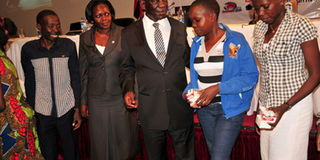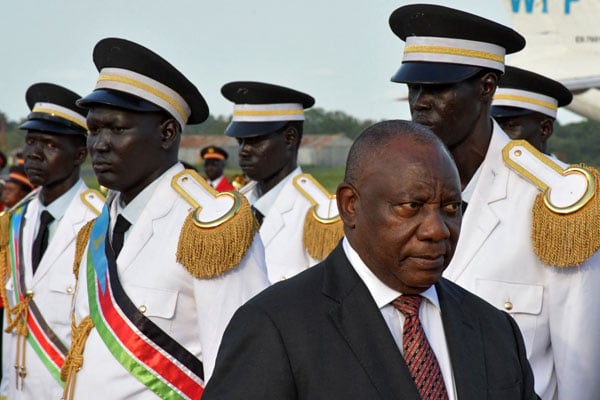‘Sickle cell trait growing strong’

Vice President Edward Ssekandi (C) and the Minister of State for Health, Ms Sarah Opendi (2ndL), pose for a photo with some of the sickle cell patients who turned up for the second annual sickle cell conference at Hotel Africana last week. PHOTO BY MICHAEL KAKUMIRIZI.
What you need to know:
A study has shown that prevalence of the disease is higher in areas most affected by malaria.
Kampala
The trait that causes sickle cell anaemia cannot be eliminated unless malaria is eliminated, a medical expert has said.
Over 20,000 babies are suspected to be born with sickle cell annually, according to the Uganda Sickle Cell Surveillance Study presented by Ms Grace Ndeezi, at the second annual sickle cell conference held last week in Kampala. Of those children born with the disease, 70 to 80 per cent die before age five.
While making a presentation at the conference, Prof Russell E Ware, the director of Cincinnati’s Children Hospital in the US, said: “Sickle cell is a life threatening illness just like other diseases like HIV; it is no easier than malaria or less complex than HIV. Because it is a protection against malaria, it will not leave unless malaria does.”
The Sickle Cell Surveillance Study revealed that the mid northern region has the highest number of sickle cell prevalence of 18.6 per cent which in turn has a malaria prevalence of 63 per cent. East central has a sickle cell prevalence of 16.7 per cent with a malaria prevalence of 56 per cent.
Ms Sarah Acheing Opendi, the State minister of Primary Health Care, said although the effects of the disease are many, sickle cell anaemia has little attention as opposed to other diseases.
“It is sad to note that in our country, very few patients have access to early diagnosis or comprehensive and on-going medi-care and therefore early death and devastating complications remain common. The World Health Organisation recognises that sickle-cell anaemia is one of the world’s foremost genetic diseases, that it has severe physical, psychological and social consequences for those affected and their families, and that in its homozygote form, it is one of the most lethal genetic diseases,” Ms Opendi said during the conference.
She pledged the support of the Ministry of Health to fight the epidemic through equipping health facilities and opening up specialised clinics in sickle cell.
While launching the one-day conference, Vice President Edward Ssekandi pledged Shs3 million to fighting the disease and re-echoed Opendi’s call to open more sickle cell specialised clinics.
“It is true that we have few specialised sickle cell clinics like the one in Mulago hospital and a small number of private clinics such as the one at Bukasa Kituntu in Mpigi. In my opinion, part of the solution for this problem lays in opening and equipping sickle cell clinics, creating funds like Uganda American Sickle Cell Rescue Fund and enhancing awareness among the ordinary people,” Mr Ssekandi said.
The conference was organised by Uganda American Sickle Cell Rescue Fund in partnership with Monitor Publications, BMK Group and Wavah Water, among others.




